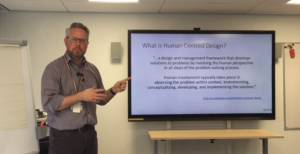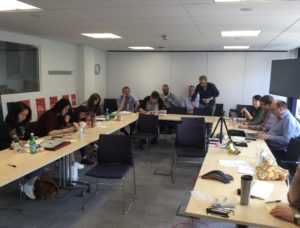A truly student-centred portal – User-focused meetup write up
In the previous lunchtime meetup, Mary Elder told us about the work that has been carried out to make MyEd a truly student-centred portal, and Neil Allison reported on the University’s Student Digital Experience Standards.
Human-centred design process
UX Service Manager Neil Allison kicked off the session by explaining the principles of human-centred design. He told us about how projects conducted with a human-centred approach go through a series of iterative stages where users are engaged with throughout the process rather than only being introduced at the end.
Involving users throughout the process with a variety of research and design techniques increases the likelihood of creating products which actually meets their needs. You can read about the human-centred design process on the UX Services website.
The human-centred design process on the UX Service website

Neil Allison on the principles of human-centred design
The UX Service aims to help project teams to adopt this approach. Neil handed over to Web Portal Service Manager Mary Elder who provided an example of this – the work that is being done to upgrade and redesign MyEd.
A truly student-centred portal: experiences in adopting a user-centred approach to MyEd
Mary’s project adopted a human-centred approach with support from the UX Service, engaging over 1500 students in research and collaborative design activities to deliver a new information architecture as well as an EdGEL-led user interface, editorial and labelling schemes, all in addition to the fundamental software upgrade which was the underlying drive for the project.
Recent blog posts about the MyEd Service development
Mary talked about the different phases of the project in relation to the human-centred design approach described earlier by Neil. We learned how the team prioritised areas to focus on, designed solutions and conducted user research to deliver maximum benefit for students.
An example of the user research conducted involved card sorting exercises to inform the information architecture of a site. In the card sorting sessions, students were given cards containing the types of tasks and information available on MyEd. They were asked to group together the cards into categories that made sense to them, label the categories and state why they made their choices.
To validate these findings , the team conducted a much larger online card sorting exercise with over a thousand students taking part. By the end, the team had a draft information architecture to begin producing the navigation structure of MyEd.
The team then concentrated on interaction, navigation and interface design. This involved iterative user testing in which the team incorporated the insight gained so far into a rapid prototyping session and quickly produced low fidelity prototypes to test with users. This gave direction to begin the development phase, which again involved iterative cycles of user testing.
Mary described the positive impacts adopting a human-centred approach had, which included:
- confidence that design decisions were well founded
- evidence for stakeholders, sponsors and content providers
- engagement from students
- knowledge and understanding about the target audience gained that will feed into future improvements
- giving various members of the project team an opportunity to observe and feel empathy for the real users
Check out Mary’s slides to learn more about the various stages of the project:
Student Digital Experience Standards
Neil followed Mary’s talk with a presentation on the Student Digital Experience Standards. The standards are being refined and revised by the UX Service to encourage project teams to adopt new skills, tools and processes aligned to industry best practice in the fields of user experience research and design. Adopting these standards gives teams a consistent, measurable approach to human-centred project delivery.
Neil explained in detail how the standards should be used to determine the success of a digital product and how as a university it is important we use the standards to cooperate, so that insight and learning becomes transferable across multiple projects.
How well the University manages to involve students’ needs, to integrate and align them together with business needs and technical constraints, and then deliver a digital service or product, will ultimately determine the success of a digital student experience. – Neil Allison
The standards are based on a set of principles that express how we should approach a digital project. Appraising your project against these standards throughout its life-cycle will reduce the risk of not delivering on aims.
You can read about the Student Digital Experience Standards in greater detail on the UX Service website.
The Student Digital Experience Standards on the UX Service website
Here are Neil’s slides from the session:
The group discussion
As always, the session was a great opportunity to meet, talk to and learn from colleagues. We followed the talks with a discussion based on a group-organised agenda. We used the Lean Coffee approach to decide what to talk about and for how long.

The group writing down discussion suggestions on post-it notes.
The challenge of researching with groups you don’t have direct access to
During the first part of the discussion we focused on the importance of recruiting representative users for our research – is it satisfactory to ask people to pretend to be the target audience? We concluded that it depends on what you are trying to achieve, what stage of research you are in and the level of risk that you are willing to take.
Identifying user needs – lessons learned from workshops
The second part of the discussion was about how to run effective workshops to find out what users need. We determined that what people say and what people do are often two different things and that what people say they want is often not what they actually need. This led us to talk about effective user research techniques and Senior User Researcher Nicola Dobiecka was on hand to reference a past meetup where she presented on how to conduct user interviews.
Avoiding bias when interviewing users – previous lunchtime meetup write up
Get in touch
If you’d like to find out more or bring the UX Service on board to help you better understand your users, get in touch.
Contact the User Experience Service
More UX meetup sessions
Keep an eye out for the next UX meetup. We would love to see you there.


1 replies to “A truly student-centred portal – User-focused meetup write up”